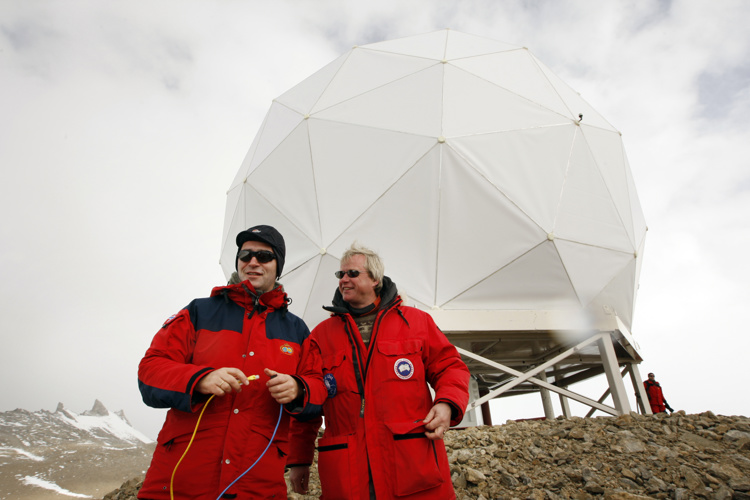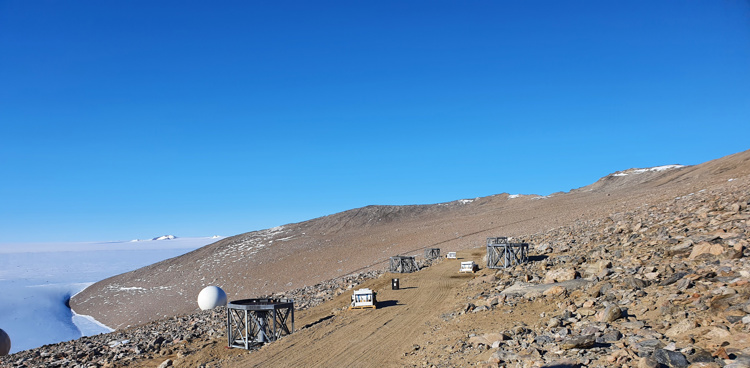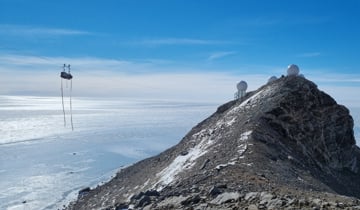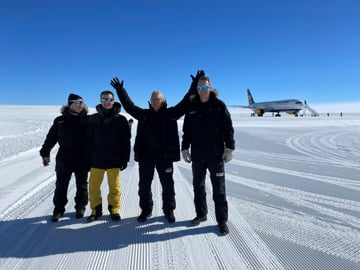Six antennas have been installed on scheduled time, a record-breaking achievement by the team, that can now return home from Antarctica after a short and intense summer season. In total KSAT now has around 20 antenna systems in place in the Antarctic ground station.
The crew is flying home on 1st of March, the same date that the Troll ground station came into operation. Located at 72' South, the only commercial ground station in Antarctica offered access to almost all orbits from the southern hemisphere. In combination with the coverage of KSAT Svalbard Ground Station, KSAT could introduce to the market a unique pole-to-pole concept offering connectivity twice per orbit for most Polar Orbiting satellites.
The official inauguration of the station took place later that year. (photo). Since coming into operation, Troll ground station has become one of KSATs most important ground stations, one of three sites in the Polar latitudes.

Unusual weather for the season
Nearly two decades later the sun still rises in west and sets in east in Antarctica. Things are different in the southern hemisphere. While there is winter in Northern Europe it’s summer in the south. But in Antarctica it doesn’t exactly feel like summer, even though the calendar says it’s peak season. The weather can be grim, and the team is leaving behind a season with unusual weather.
– This season the weather has been “interesting” to say the least. It’s been snowing far more than usual, KSAT system engineer Thomas Rochmann says. It’s his third season at Troll Station, so he’s not new to the game of building and maintaining antennas in one of the most remote corners of the world.

The work of building six antennas has been going smoothly, but it’s been intense.
– We have done everything on scheduled time, even though some of the work that was supposed to be completed before our arrival was severely delayed due to the challenging weather, he says.

Already six fundaments laid out, they are next to each other.
Busiest season ever
The crew has worked around the clock to get the scheduled work done. The narrow summer window in Antarctica is not open for long. The crew has to return home before the winters sets in and no planes can take off or land. In the summer season there is only one plane a month. A small team from The Norwegian Polar Institute runs the research station and stays for the full year.
For the building of the new antennas – and maintenance of the ones already in operation - KSAT has a crew of seven people, engineers mainly.
– We are happy that we have done everything on time. Now it’s all about finishing the work, and make sure the station is left like it was when we arrived. Next year we’ll come back to a tidy station, Rochmann says. Travelling back home means spending almost 24 hours on a plane.

Experience and resilience
The work this season at Troll Station has spanned from digging in the ground to studying RF signals, from manual work to programming of the most advanced technology. But that is what characterizes KSAT: We are experts not only on antennas as such, but the complete production platform. We do everything from mechanical installation of the foundations to installing and commissioning the antenna systems.
– I truly think this is what makes us unique. It’s a team effort, everyone knows what they are doing, all the disciplines come together nicely, Thomas Rochmann says.
Now that the antennas are in place, it’s the engineers at our head office in Norway that pick up the baton, to get the systems up and running.



